Spatiotemporal Analysis of Air Pollution and Climate Change Effects on Urban Green Spaces in Bucharest Metropolis
Abstract
1. Introduction
2. Materials and Methods
2.1. Study Test Area
2.2. Data Sets
- (1)
- Air quality data. AQICN (World Air Quality Index) [46] and local monitoring networks supplied the daily mean time series data for air pollutant concentrations.
- (2)
- Potential climate driving factors. This study used the daily mean time series of climate data (air temperature (TA) at 2 m height, air relative humidity (RH), air pressure (p), wind speed intensity (w) and direction, planetary boundary layer height (PBL), and solar surface irradiance (SI)) provided by MERRA-2 Version 2 (Modern-Era Retrospective Analysis for Research and Applications) [47] and C3S (Copernicus Climate Change Service) [48], and NASA’s online database by Goddard Earth Sciences Data and Information Services Center (GES DISC) released Geospatial Interactive Online Visualization and Analysis Infrastructure (GIOVANNI) V4.28 via its portal [49].
- From the Terrestrial Ecology Subsetting & Visualization Services (TESViS)
- Global Subsets Tool from the ORNL DAAC, MODIS Terra/Aqua data [50]:
- (3)
- MODIS LST data: among the available LST products developed through the different retrieval algorithms based on TIR sensors from different satellite missions (TM/ETM+/OLI, AVHRR, SENTINEL, AMSR-E, AATSR, and VIRR), MODIS Terra/Aqua is considered the most suitable data source for LST monitoring due to its high observation frequency, moderate spatial resolution, and free availability [51,52]. This study used the NASA MODIS/VIIRS Land Products Global Subsetting Tool at the ORNL DAAC, MOD11A2 LST_Day_1 km and MOD11A2 LST_Night_1 km collected within 8 days [53], providing time series LST data for the Bucharest metropolitan area. Several studies found that the root mean square error (RMSE) of the MODIS LST data is within 2.0 °C and exhibits high accuracy in the major global cities [54].
- (4)
- MODIS NDVI data: MOD13Q1 MODIS/Terra Vegetation Indices NDVI/EVI 16-Day L3 Global 250 m SIN Grid V06116-day.
- (5)
- MODIS LAI/FPAR data: MOD15A2H MODIS/Terra Leaf Area Index/FPAR 8-Day with 500 m spatial resolution, mainly for their capacity to detect anthropogenic and climate impacts on urban vegetation land cover changes.
- (6)
- MODIS LSA (land Surface Albedo): MCD43A1 MODIS/Terra+Aqua BRDF/Albedo Model Parameters Daily L3 Global–500 m V061.
- (7)
- MOD16A2ET_500 m at 8 days for evapotranspiration monitoring.
- (8)
- MOD17A3HGF v061: MODIS/Terra Net Primary Production Gap-Filled Yearly L4 Global 500 m SIN Grid.
2.3. Methodology
3. Results and Discussion
3.1. Land Use/Cover Changes in Bucharest
3.2. Normalized Difference Vegetation Indices’ Spatiotemporal Variability
3.3. Impact of Air Pollution on Urban Vegetation
3.4. Impact of Climate on Normalized Difference Vegetation Indices
3.4.1. Air Temperature Impact on NDVI
3.4.2. Land Surface Temperature’s Impact on NDVI
3.4.3. Land Surface Albedo Impact on NDVI
3.4.4. Solar Surface Irradiance’s Impact on NDVI
3.5. Climate Impact on Evapotranspiration
3.6. Impact of Climate on Leaf Area Index and Photosynthetically Active Radiation
3.7. Impact of Climate and Anthropogenic Changes on Vegetation Net Primary Production
3.8. Study Limitations and Perspectives
4. Conclusions
Author Contributions
Funding
Institutional Review Board Statement
Informed Consent Statement
Data Availability Statement
Acknowledgments
Conflicts of Interest
References
- Jeong, A.; Lovison, G.; Bussalleu, A.; Cirach, M.; Dadvand, P.; de Hoogh, K.; Flexeder, C.; Hoek, G.; Imboden, M.; Karrasch, S.; et al. Lung function-associated exposome profile in the era of climate change: Pooled analysis of 8 population-based European cohorts within the EXPANSE project. Environ. Int. 2025, 196, 109269. [Google Scholar] [CrossRef]
- Kašpar, J.; Král, K.; Levanič, T.; Adamič, P.C.; Čater, M. Climate growth limitations of European beech and silver fir along the Carpathian arc—The recent state and future prospects. Agric. For. Meteorol. 2025, 361, 110323. [Google Scholar] [CrossRef]
- Biagi, B.; Brattich, E.; Cintoles, C.; Barbano, F.; Di Sabatino, S. Dynamical and chemical impacts of urban green areas on air pollution in a city environment. Urban Clim. 2025, 60, 102343. [Google Scholar] [CrossRef]
- Sharma, S.; Hussain, S.; Kumar, P.; Singh, A.N. Urban trees’ potential for regulatory services in the urban environment: An exploration of carbon sequestration. Environ. Monit. Assess. 2024, 196, 504. [Google Scholar] [CrossRef] [PubMed]
- Steinparzer, M.; Schaubmayr, J.; Godbold, D.L.; Rewald, B. Particulate matter accumulation by tree foliage is driven by leaf habit types, urbanization-and pollution levels. Environ. Pollut. 2023, 335, 122289. [Google Scholar] [CrossRef]
- Lopes, H.S.; Vidal, D.G.; Cherif, N.; Silva, L.; Remoaldo, P.C. Green infrastructure and its influence on urban heat island, heat risk, and air pollution: A case study of Porto (Portugal). J. Environ. Manag. 2025, 376, 124446. [Google Scholar] [CrossRef]
- Wang, C.; Jin, J.; Davies, C.; Chen, W.Y. Urban forests as nature-based solutions: A comprehensive overview of the national forest city action in China. Curr. For. Rep. 2024, 10, 119–132. [Google Scholar] [CrossRef]
- Chen, D.; Sun, W.; Shi, J.; Johnson, B.A.; Tan, M.L.; Pan, Q.; Li, W.; Yang, X.; Zhang, F. Utilizing GaoFen-2 derived urban green space information to predict local surface temperature. Urban For. Urban Green. 2024, 99, 128463. [Google Scholar] [CrossRef]
- Liu, Y.; Tang, G. Contradictory response of ozone and particulate matter concentrations to boundary layer meteorology. Environ. Pollut. 2024, 343, 123209. [Google Scholar] [CrossRef]
- Xiang, Y.; Zhang, T.; Liu, J.; Lv, L.; Dong, Y.; Chen, Z. Atmosphere boundary layer height and its effect on air pollutants in Beijing during winter heavy pollution. Atmos. Res. 2019, 215, 305–316. [Google Scholar] [CrossRef]
- Girotti, C.; Kowalski, L.F.; Silva, T.; Correia, E.; Shimomura, A.R.P.; Kurokawa, F.A.; Lopes, A. Air pollution Dynamics: The role of meteorological factors in PM10 concentration patterns across urban areas. City Environ. Interact. 2025, 25, 100184. [Google Scholar] [CrossRef]
- Chen, Y.; Chen, S.; Zhao, D.; Li, J.; Bi, H.; Lou, G.; Guan, Y. The role of boundary layer height in India on transboundary pollutions to the Tibetan Plateau. Sci. Total Environ. 2022, 837, 155816. [Google Scholar] [CrossRef] [PubMed]
- Buccolieri, R.; Santiago, J.-L.; Rivas, E.; Sáanchez, B. Reprint of: Review on urban tree modelling in CFD simulations: Aerodynamic, deposition and thermal effects. Urban For. Urban Green. 2019, 37, 56–64. [Google Scholar] [CrossRef]
- Santiago, J.-L.; Martilli, A.; Martin, F. On dry deposition modelling of atmospheric pollutants on vegetation at the microscale: Application to the impact of street vegetation on air quality. Bound.-Layer. Meteorol. 2017, 162, 451–474. [Google Scholar] [CrossRef]
- Mehmood, Z.; Yang, H.-H.; Awan, M.U.F.; Ahmed, U.; Hasnain, A.; Luqman, M.; Muhammad, S.; Sardar, A.A.; Chan, T.-Y.; Sharjeel, A. Effects of Air Pollution on Morphological, Biochemical, DNA, and Tolerance Ability of Roadside Plant Species. Sustainability 2024, 16, 3427. [Google Scholar] [CrossRef]
- Xu, X.; Zhang, Z.; Bao, L.; Mo, L.; Yu, X.; Fan, D.; Lun, X. Influence of rainfall duration and intensity on particulate matter removal from plant leaves. Sci. Total Environ. 2017, 609, 11–16. [Google Scholar] [CrossRef]
- Zhou, S.J.; Cong, L.; Liu, Y.; Xie, L.M.; Zhao, S.Q.; Zhang, Z.M. Rainfall intensity plays an important role in the removal of PM from the leaf surfaces. Ecol. Indic. 2021, 128, 107778. [Google Scholar] [CrossRef]
- Andrade, G.C.; Santana, B.V.N.; Rinaldi, M.C.S.; Ferreira, S.O.; da Silva, R.C.; da Silva, L.C. Leaf surface traits related to differential particle adsorption—A case study of two tropical legumes. Sci. Total Environ. 2022, 823, 153681. [Google Scholar] [CrossRef] [PubMed]
- Chen, L.; Liu, C.; Zhang, L.; Zou, R.; Zhang, Z. Variation in tree species ability to capture and retain airborne fine particulate matter (PM 2.5). Sci. Rep. 2017, 7, 3206. [Google Scholar]
- Chiam, Z.Y.; Song, X.P.; Lai, H.R.; Tan, H.T.W. Particulate matter mitigation via plants: Understanding complex relationships with leaf traits. Sci. Total Environ. 2019, 688, 398–408. [Google Scholar] [CrossRef]
- Corada, K.; Woodward, H.; Alaraj, H.; Collins, C.M.; de Nazelle, A. A systematic review of the leaf traits considered to contribute to removal of airborne particulate matter pollution in urban areas. Environ. Pollut. 2020, 269, 116104. [Google Scholar] [CrossRef] [PubMed]
- Delaria, E.R.; Place, B.K.; Liu, A.X.; Cohen, R.C. Laboratory measurements of stomatal NO2 deposition to native California trees and the role of forests in the NO cycle. Atmos. Chem. Phys. 2020, 20, 14023–14041. [Google Scholar] [CrossRef]
- Lee, J.K.; Woo, S.Y.; Kwak, M.J.; Park, S.H.; Kim, H.D.; Lim, Y.J.; Park, J.H.; Lee, K.A. Effects of elevated temperature and ozone in Brassica juncea L.: Growth, physiology, and ROS accumulation. Forests 2020, 11, 68. [Google Scholar] [CrossRef]
- Lindén, J.; Gustafsson, M.; Uddling, J.; Watne, Å.; Pleijel, H. Air pollution removal through deposition on urban vegetation: The importance of vegetation characteristics. Urban For. Urban Green. 2023, 81, 127843. [Google Scholar] [CrossRef]
- Redondo-Bermudez, M.D.; Gulenc, I.T.; Cameron, R.W.; Inkson, B.J. ‘Green barriers’ for air pollutant capture: Leaf micromorphology as a mechanism to explain plants capacity to capture particulate matter. Environ. Pollut. 2021, 288, 117809. [Google Scholar] [CrossRef]
- Xu, L.S.; Yan, Q.; Liu, L.W.; He, P.; Zhen, Z.L.; Duan, Y.H.; Jing, Y.D. Variations of particulate matter retention by foliage after wind and rain disturbance. Air Qual. Atmos. Health 2022, 15, 437–447. [Google Scholar] [CrossRef]
- Singh, S.; Pandey, B.; Roy, L.B.; Shekhar, S.; Singh, R.K. Tree responses to foliar dust deposition and gradient of air pollution around opencast coal mines of Jharia coalfield, India: Gas exchange, antioxidative potential and tolerance level. Environ. Sci. Pollut. Res. 2020, 28, 8637–8651. [Google Scholar] [CrossRef]
- Mukherjee, A.; Agrawal, M. Use of GLM approach to assess the responses of tropical trees to urban air pollution in relation to leaf functional traits and tree characteristics. Ecotoxicol. Environ. Saf. 2018, 152, 42–54. [Google Scholar] [CrossRef]
- You, H.N.; Kwak, M.J.; Je, S.M.; Lee, J.K.; Lim, Y.J.; Kim, H.; Park, S.; Jeong, S.G.; Choi, Y.S.; Woo, S.Y. Morpho-Physio-Biochemical Attributes of Roadside Trees as Potential Tools for Biomonitoring of Air Quality and Environmental Health in Urban Areas. Land 2021, 10, 236. [Google Scholar] [CrossRef]
- Yao, J.; Wu, S.; Cao, Y.; Wei, J.; Tang, X.; Hu, L.; Wu, J.; Yang, H.; Yang, J.; Ji, X. Dry deposition effect of urban green spaces on ambient particulate matter pollution in China. Sci. Total Environ. 2023, 900, 165830. [Google Scholar] [CrossRef]
- Gustafsson, M.; Lindén, J.; Johansson, E.M.M.; Watne, A.K.; Pleijel, H. Air pollution removal with urban greenery—Introducing the Vegetation Impact Dynamic Assessment model (VIDA). Atmos. Environ. 2024, 323, 120397. [Google Scholar] [CrossRef]
- Kwak, M.J.; Lee, J.K.; Park, S.; Kim, H.; Lim, Y.J.; Lee, K.A.; Son, J.A.; Oh, C.Y.; Kim, I.; Woo, S.Y. Surface-based analysis of leaf microstructures for adsorbing and retaining capability of airborne particulate matter in ten woody species. Forests 2020, 11, 946. [Google Scholar] [CrossRef]
- Batkhuyag, E.-U.; Lehmann, M.M.; Cherubini, P.; Ulziibat, B.; Soyol-Erdene, T.-O.; Schaub, M.; Saurer, M. Combination of multiple stable isotope and elemental analyses in urban trees reveals air pollution and climate change effects in Central Mongolia. Ecol. Indic. 2023, 154, 110719. [Google Scholar] [CrossRef]
- New EU Forest Strategy for 2030. 2022. Available online: https://www.europarl.europa.eu/RegData/etudes/ATAG/2022/698936/EPRS_ATA(2022)698936_EN.pdf (accessed on 2 March 2025).
- Environment European Commission. Degraded Ecosystems to Be Restored Across Europe as Nature Restoration Law Enters into Force. 2024. Available online: https://environment.ec.europa.eu/news/nature-restoration-law-enters-force-2024-08-15_en?prefLang=ro (accessed on 10 March 2025).
- de Souza, A.; de Oliveira-Júnior, J.F.; Cardoso, K.R.A.; Gautam, S. Impact of vehicular emissions on ozone levels: A comprehensive study of nitric oxide and ozone interactions in urban areas. Geosyst. Geoenviron. 2025, 4, 100348. [Google Scholar] [CrossRef]
- Zoran, M.; Savastru, R.; Savastru, D.; Tautan, M.; Tenciu, D. Linkage between Airborne Particulate Matter and Viral Pandemic COVID-19 in Bucharest. Microorganisms 2023, 11, 2531. [Google Scholar] [CrossRef]
- Dușcu, D.-M.; Rîșnoveanu, G. Understanding visitor preferences: Perceived importance of anthropogenic and natural forest features in supplying cultural ecosystem services. For. Ecosyst. 2025, 13, 100306. [Google Scholar] [CrossRef]
- Mărmureanu, L.; Leca, Ş.; Pitar, D.; Pascu, I.; De Marco, A.; Sicard, P.; Chivulescu, Ş.; Dobre, A.C.; Badea, O. Estimation of plant pollution removal capacity based on intensive air quality measurements. Environ. Res. 2024, 261, 119703. [Google Scholar] [CrossRef]
- Araminienė, V.; Sicard, P.; Černiauskas, V.; Coulibaly, F.; Varnagirytė-Kabašinskienė, I. Estimation of air pollution removal capacity by urban vegetation from very high-resolution satellite images in Lithuania. Urban Clim. 2023, 51, 101594. [Google Scholar] [CrossRef]
- Ferrini, F.; Fini, A.; Mori, J.; Gori, A. Role of vegetation as a mitigating factor in the urban context. Sustainability 2020, 12, 4247. [Google Scholar] [CrossRef]
- Yao, M.; Smith, M.; Peng, C. Modelling the effects of vegetation and urban form on air quality in real urban environments: A systematic review of measurements, methods, and predictions. Urban For. Urban Green. 2025, 105, 128693. [Google Scholar] [CrossRef]
- National Institute of Statistics. INS Baze de Date Statistice. 2025. Available online: http://statistici.insse.ro:8077/tempo-online/#/pages/tables/insse-table (accessed on 10 March 2025).
- National Institute of Statistics. Available online: https://insse.ro/cms/ro/publicatii-statistice-in-format-electronic (accessed on 10 March 2025).
- Popescu, L.; Popescu, R.; Catalina, T. Indoor particle’s pollution in Bucharest, Romania. Toxics 2022, 10, 757. [Google Scholar] [CrossRef] [PubMed]
- AQICN. 2023. Available online: https://aqicn.org/city/ (accessed on 28 February 2025).
- MERRA. 2025. Available online: http://www.soda-pro.com/web-services/meteo-data/merra (accessed on 25 February 2025).
- Copernicus. 2025. Available online: https://cds.climate.copernicus.eu/ (accessed on 2 February 2025).
- GIOVANNI. 2025. Geospatial Interactive Online Visualization and Analysis Infrastructure GIOVANNI. Available online: https://giovanni.gsfc.nasa.gov/giovanni (accessed on 20 February 2025).
- NASA MODIS. Available online: https://modis.ornl.gov/ (accessed on 20 February 2025).
- Nour Eldeen, N.; Mao, K.; Yuan, Z.; Shen, X.; Xu, T.; Qin, Z. Analysis of the spatiotemporal change in land surface temperature for a long-term sequence in africa (2003–2017). Remote Sens. 2020, 12, 488–511. [Google Scholar] [CrossRef]
- Phan, T.N.; Kappas, M.; Nguyen, K.T.; Tran, T.P.; Tran, Q.V.; Emam, A.R. Evaluation of modis land surface temperature products for daily air surface temperature estimation in northwest Vietnam. Int. J. Remote Sens. 2019, 40, 5544–5562. [Google Scholar] [CrossRef]
- ORNL DAAC. MODIS and VIIRS Land Products Global Subsetting and Visualization Tool; ORNL DAAC: Oak Ridge, TN, USA, 2018. [Google Scholar] [CrossRef]
- Yoo, C.; Im, J.; Cho, D.; Yokoya, N.; Xia, J.; Bechtel, B. Estimation of all-weather 1 km MODIS land surface temperature for humid summer days. Remote Sens. 2020, 12, 1398. [Google Scholar] [CrossRef]
- de la Iglesia Martinez, A.; Labib, S.M. Demystifying normalized difference vegetation index (NDVI) for greenness exposure assessments and policy interventions in urban greening. Environ. Res. 2023, 220, 115155. [Google Scholar] [CrossRef] [PubMed]
- Al-Hameed, A.A.K. Spearman’s correlation coefficient in statistical analysis. Int. J. Nonlinear Anal. Appl. 2022, 13, 3249–3255. [Google Scholar]
- Copernicus Urban Atlas. Available online: https://land.copernicus.eu/local/urban-atlas/urban-atlas-2018 (accessed on 20 February 2025).
- Bacău, S.; Domingo, D.; Palka, G.; Pellissier, L.; Kienast, F. Integrating strategic planning intentions into land-change simulations: Designing and assessing scenarios for Bucharest. Sustain. Cities Soc. 2022, 76, 103446. [Google Scholar] [CrossRef]
- Eisfelder, C.; Asam, S.; Hirner, A.; Reiners, P.; Holzwarth, S.; Bachmann, M.; Gessner, U.; Dietz, A.; Huth, J.; Bachofer, F.; et al. Seasonal Vegetation Trends for Europe over 30 Years from a Novel Normalised Difference Vegetation Index (NDVI) Time-Series—The TIMELINE NDVI Product. Remote Sens. 2023, 15, 3616. [Google Scholar] [CrossRef]
- Prăvălie, R.; Sirodoev, I.; Nita, I.A.; Patriche, C.; Dumitraşcu, M.; Roşca, B.; Tişcovschi, A.; Bandoc, G.; Săvulescu, I.; Mănoiu, V.; et al. NDVI-based ecological dynamics of forest vegetation and its relationship to climate change in Romania during 1987–2018. Ecol. Indic. 2022, 136, 108629. [Google Scholar] [CrossRef]
- Klimavičius, L.; Rimkus, E.; Stonevičius, E.; Mačiulytė, V. Seasonality and long-term trends of NDVI values in different land use types in the eastern part of the Baltic Sea basin. Oceanologia 2023, 65, 171–181. [Google Scholar] [CrossRef]
- Beloconi, A.; Vounatsou, P. Revised EU and WHO air quality thresholds: Where does Europe stand? Atmos. Environ. 2023, 314, 120110. [Google Scholar] [CrossRef]
- Zoran, M.; Savastru, R.; Savastru, D.; Tautan, M. Impacts of exposure to air pollution, radon, and climate drivers on the COVID-19 pandemic in Bucharest, Romania: A time series study. Environ. Res. 2022, 212, 113437. [Google Scholar] [CrossRef] [PubMed]
- Yang, W.; Lin, W.; Li, Y.; Shi, Y.; Xiong, Y. Estimating the seasonal and spatial variation of urban vegetation’s PM2.5 removal capacity. Environ. Pollut. 2025, 369, 125800. [Google Scholar] [CrossRef] [PubMed]
- Islam, A.; Pattnaik, N.; Moula, M.M.; Rötzer, T.; Pauleit, S.; Rahman, M.A. Impact of urban green spaces on air quality: A study of PM10 reduction across diverse climates. Sci. Total Environ. 2024, 955, 176770. [Google Scholar] [CrossRef]
- Sohrab, S.; Csikos, N.; Szilassi, P. Effects of land use patterns on PM10 concentrations in urban and suburban areas. A European scale analysis. Atmos. Pollut. Res. 2023, 14, 101942. [Google Scholar] [CrossRef]
- Yao, L.; Li, T.; Xu, M.; Xu, Y. How the landscape features of urban green space impact seasonal land surface temperatures at a city-block-scale: An urban heat island study in Beijing, China. Urban For. Urban Green. 2020, 52, 126704. [Google Scholar] [CrossRef]
- Vigevani, I.; Corsini, D.; Comin, S.; Fini, A.; Ferrini, F. Methods to quantify particle air 361 pollution removal by urban vegetation: A review. Atmos. Environ. X 2023, 21, 100233. [Google Scholar] [CrossRef]
- Chen, D.; Yan, J.; Sun, N.; Sun, W.; Zhang, W.; Long, Y.; Yin, S. Selective capture of PM2.5 by urban trees: The role of leaf wax composition and physiological traits in air quality enhancement. J. Hazard. Mater. 2024, 478, 135428. [Google Scholar] [CrossRef] [PubMed]
- Sheng, Q.; Zhang, C.; Huang, Y.; Jia, C.; Liu, C.; Dai, A.; Zhu, Z.; Huang, Z. The mediating effect of microclimate in the impacts of roadside vegetation barriers on air pollution in pedestrian spaces. Build. Environ. 2025, 279, 113052. [Google Scholar] [CrossRef]
- Oliveira, M.C.Q.D.; de Miranda, R.M.; de Fátima Andrade, M.; Kumar, P. Impact of urban green areas on air quality: An integrated analysis in the metropolitan area of São Paulo. Environ. Pollut. 2025, 372, 126082. [Google Scholar] [CrossRef]
- Cichowicz, R.; Bochenek, A.D. Assessing the effects of urban heat islands and air pollution on human quality of life. Anthropocene 2024, 46, 100433. [Google Scholar] [CrossRef]
- Zhang, Y.; Ge, J.; Wang, S.; Dong, C. Optimizing urban green space configurations for enhanced heat island mitigation: A geographically weighted machine learning approach. Sustain. Cities Soc. 2025, 119, 106087. [Google Scholar] [CrossRef]
- Han, L.; Zhang, R.; Wang, J.; Cao, S.J. Spatial synergistic effect of urban green space ecosystem on air pollution and heat island effect. Urban Clim. 2024, 55, 101940. [Google Scholar] [CrossRef]
- Sun, X.; Fang, P.; Huang, S.; Liang, Y.; Zhang, J.; Wang, J. Impact of urban green space morphology and vegetation composition on seasonal land surface temperature: A case study of Beijing’s urban core. Urban Clim. 2025, 60, 102367. [Google Scholar] [CrossRef]
- Zhang, J.; Hong, S.; Chen, B.; Wu, S. Multiscale synergistic effects of urban green space morphology on heat-pollution: A case study of Guangdong-Hong Kong-Macao Greater Bay Area, China. Ecol. Indic. 2025, 173, 113390. [Google Scholar] [CrossRef]
- Smith, I.A.; Fabian, M.P.; Hutyra, L.R. Urban green space and albedo impacts on surface temperature across seven United States cities. Sci. Total Environ. 2023, 857, 159663. [Google Scholar] [CrossRef]
- Arunab, K.S.; Mathew, A. Quantifying urban heat island and pollutant nexus: A novel geospatial approach. Sustain. Cities Soc. 2024, 101, 105117. [Google Scholar] [CrossRef]
- Ngarambe, J.; Joen, S.J.; Han, C.H.; Yun, G.Y. Exploring the relationship between particulate matter, CO, SO2, NO2, O3 and urban heat island in Seoul, Korea. J. Hazard. Mater. 2021, 403, 123615. [Google Scholar] [CrossRef]
- Yu, H.; Piao, Y. The Cooling Effect and Its Stability in Urban Green Space in the Context of Global Warming: A Case Study of Changchun, China. Sustainability 2025, 17, 2590. [Google Scholar] [CrossRef]
- Beele, E.; Aerts, R.; Reyniers, M.; Somers, B. Spatial configuration of green space matters: Associations between urban land cover and air temperature. Landsc. Urban Plan. 2024, 249, 105121. [Google Scholar] [CrossRef]
- Liang, S.; Ma, W.; Sui, X.; Wang, M.; Li, H. An Assessment of Relations between Vegetation Green FPARandVegetation Indices through a Radiative Transfer Model. Plants 2023, 12, 1927. [Google Scholar] [CrossRef] [PubMed]
- Wang, A.; Wang, J.; Zhang, R.; Cao, S.-J. Mitigating urban heat and air pollution considering green and transportation infrastructure. Transp. Res. Part A Policy Pract. 2024, 184, 104079. [Google Scholar] [CrossRef]
- Klopfer, F. The thermal performance of urban form—An analysis on urban structure types in Berlin. Appl. Geogr. 2023, 152, 102890. [Google Scholar] [CrossRef]
- Tuoku, L.; Wu, Z.; Men, B. Impacts of climate factors and human activities on NDVI change in China. Ecol. Inform. 2024, 81, 102555. [Google Scholar] [CrossRef]
- Dash, S.; Maity, R. Association between hydroclimatic factors and vegetation health: Impact of climate change in the past and future. Sci. Total Environ. 2025, 964, 178605. [Google Scholar] [CrossRef]
- Huang, Q.; Xu, C.; Haase, D.; Teng, Y.; Su, M.; Yang, Z. Heterogeneous effects of the availability and spatial configuration of urban green spaces on their cooling effects in China. Environ. Int. 2024, 183, 108385. [Google Scholar] [CrossRef]
- Yu, L.; Liu, Y.; Li, X.; Yan, F.; Lyne, V.; Liu, T. Vegetation-induced asymmetric diurnal land surface temperatures changes across global climate zones. Sci. Total Environ. 2023, 896, 165255. [Google Scholar] [CrossRef] [PubMed]
- Zhou, W.; Yu, Y.; Zhang, S.; Xu, J.; Wu, T. Methods for quantifying the cooling effect of urban green spaces using remote sensing: A comparative study. Landsc. Urban Plan. 2025, 256, 105289. [Google Scholar] [CrossRef]
- Sheng, Q.; Ji, Y.; Jia, C.; Jiang, L.; Li, C.; Huang, Z.; Ma, C.; Zhang, X.; Chen, H.; Wang, T.; et al. Differential effects of cooling and humidification in urban green spaces and thresholds of vegetation community structure parameters: A case study of the Yangtze River Delta region. Cities 2025, 159, 105765. [Google Scholar] [CrossRef]
- Guidolotti, G.; Zenone, T.; Endreny, T.; Pace, R.; Ciolfi, M.; Mattioni, M.; Pallozzi, E.; Rezaie, N.; Bertolini, T.; Corradi, C.; et al. Impact of drought on cooling capacity and carbon sequestration in urban green area. Urban Clim. 2025, 59, 102244. [Google Scholar] [CrossRef]
- Ma, J.; Wang, S.; Chen, G.C.; Zhu, S.; Wang, P.; Chen, J.; Zhang, H. Estimating emissions of biogenic volatile organic compounds from urban green spaces and their contributions to secondary pollution. Environ. Sci. Atmos. 2024, 5, 129–141. [Google Scholar] [CrossRef]
- Anees, S.A.; Mehmood, K.; Rehman, A.; Rehman, N.U.; Muhammad, S.; Shahzad, F.; Hussain, K.; Luo, M.; Alarfaj, A.A.; Alharbi, S.A.; et al. Unveiling fractional vegetation cover dynamics: A spatiotemporal analysis using MODIS NDVI and machine learning. Environ. Sustain. Indic. 2024, 24, 100485. [Google Scholar] [CrossRef]
- Mehmood, K.; Anees, S.A.; Muhammad, S.; Hussain, K.; Shahzad, F.; Liu, Q.; Ansari, M.J.; Alharbi, S.A.; Khan, W.R. Analyzing vegetation health dynamics across seasons and regions through NDVI and climatic variables. Sci. Rep. 2024, 14, 11775. [Google Scholar] [CrossRef]
- Guo, J.; Fan, L.; Feng, P.; Sun, X.; Xue, S. Response of vegetation evapotranspiration to landscape pattern changes in an arid region: A case study of the Loess Plateau, China. CATENA 2025, 252, 108878. [Google Scholar] [CrossRef]
- Lin, G.; Zhao, H.; Chi, Y. A comprehensive evaluation of deep learning approaches for ground-level ozone prediction across different regions. Ecol. Inform. 2025, 86, 103024. [Google Scholar] [CrossRef]
- Motlagh, O.R.K.; Darand, M. Identification of the Driving factors impacts of Land Surface Albedo over Iran: An analysis with the MODIS data. J. Atmos. Sol.-Terr. Phys. 2024, 265, 106378. [Google Scholar] [CrossRef]
- Chen, S.; Huang, Y.; Gao, S.; Wang, G. Impact of physiological and phenological change on carbon uptake on the Tibetan Plateau revealed through GPP estimation based on spaceborne solar-induced fluorescence. Sci. Total Environ. 2019, 663, 45–59. [Google Scholar] [CrossRef]
- Wang, A.; Ren, C.; Wang, J.; Feng, Z.; Kumar, P.; Haghighat, F.; Cao, S.J. Health assessment and mitigating solutions to heat-pollution induced by urban traffic. J. Clean. Prod. 2024, 434, 140097. [Google Scholar] [CrossRef]
- Li, Z.; Zhang, H.; Juan, Y.H.; Lee, Y.T.; Wen, C.Y.; Yang, A.S. Effects of urban tree planting on thermal comfort and air quality in the street canyon in a subtropical climate. Sustain. Cities Soc. 2023, 91, 104334. [Google Scholar] [CrossRef]
- Cao, W.; Zhou, W.; Yu, W.; Wu, T. Combined effects of urban forests on land surface temperature and PM2.5 pollution in the winter and summer. Sustain. Cities Soc. 2024, 104, 105309. [Google Scholar] [CrossRef]
- Azizi, S.; Azizi, T. Urban Climate Dynamics: Analyzing the Impact of Green Cover and Air Pollution on Land Surface Temperature—A Comparative Study Across Chicago, San Francisco, and Phoenix, USA. Atmosphere 2024, 15, 917. [Google Scholar] [CrossRef]
- Liang, S.; Xu, D.; Luo, D.; Xiao, A.; Yuan, X. Study on the Impact of Land Use and Climate Change on the Spatiotemporal Evolution of Vegetation Cover in Chongqing, China. Atmosphere 2025, 16, 25. [Google Scholar] [CrossRef]
- Zhu, L.; Chen, T.; Chen, X.; Liu, S.; Zhou, S.; Wang, S.; Li, W. Investigation of the Key Drivers of Vegetation Change Based on a Paired Land Use Experiment Approach—A Case Study of the Emin River Transboundary Basin. Land 2025, 14, 437. [Google Scholar] [CrossRef]
- Tao, Y.; Peng, N.; Fan, W.; Mu, X.; Letu, H.; Ma, R.; Yang, S.; He, Q.; Zhai, D.; Ren, H. High spatiotemporal resolution vegetation FAPAR estimation from Sentinel-2 based on the spectral invariant theory. Sci. Remote Sens. 2025, 11, 100207. [Google Scholar] [CrossRef]
- Li, Y.; Huang, S.; Fang, P.; Liang, Y.; Wang, J. Human activity’s impact on urban vegetation in China during the COVID-19 lockdown: An atypical anthropogenic disturbance. iScience 2025, 28, 4112195. [Google Scholar] [CrossRef] [PubMed]
- Savastru, D.; Zoran, M.; Savastru, R.; Tautan, M.; Tenciu, V. Effects of Climate Change and Urbanization on Vegetation Phenology in the Bucharest Metropolitan Area. WSEAS Trans. Environ. Dev. 2023, 19, 961–968. [Google Scholar] [CrossRef]
- Wang, J.; Shao, Z.; Fu, P.; Zhuang, Q.; Chang, J.; Jing, P.; Zhao, Z.; Xu, Z.; Wang, S.; Yang, F. Unraveling the impact of urban expansion on vegetation carbon sequestration capacity: A case study of the Yangtze River Economic Belt. Sustain. Cities Soc. 2025, 120, 106157. [Google Scholar] [CrossRef]
- Bügelmayer-Blaschek, M.; Züger, J.; Tötzer, T. Assessing the potential of urban wide greening for climate-resilience: The example of Vienna. Sustain. Futures 2025, 9, 100532. [Google Scholar] [CrossRef]
- Zhen, Z.; Chen, S.; Lauret, N.; Kallel, A.; Chavanon, E.; Yin, T.; León-Tavares, J.; Cao, B.; Guilleux, J.; Gastellu-Etchegorry, J.-P. A gradient-based 3D nonlinear spectral model for providing components optical properties of mixed pixels in shortwave urban images. Remote Sens. Environ. 2025, 321, 114657. [Google Scholar] [CrossRef]
- Chen, S.; Ren, H.; Ye, X.; Dong, J.; Zheng, Y. Geometry and adjacency effects in urban land surface temperature retrieval from high-spatial-resolution thermal infrared images. Remote Sens. Environ. 2021, 262, 112518. [Google Scholar] [CrossRef]
- Darabi, H.; Haghighi, A.T.; Klöve, B.; Luoto, M. Remote sensing of vegetation trends: A review of methodological choices and sources of uncertainty. Remote Sens. Appl. Soc. Environ. 2025, 37, 101500. [Google Scholar] [CrossRef]
- Manzini, J.; Hoshika, Y.; Carrari, E.; Sicard, P.; Watanabe, M.; Tanaka, R.; Badea, O.; Nicese, F.P.; Ferrini, F.; Paoletti, E. FlorTree: A unifying modelling framework for estimating the species-specific pollution removal by individual trees and shrubs. Urban For. Urban Green. 2023, 85, 127967. [Google Scholar] [CrossRef]
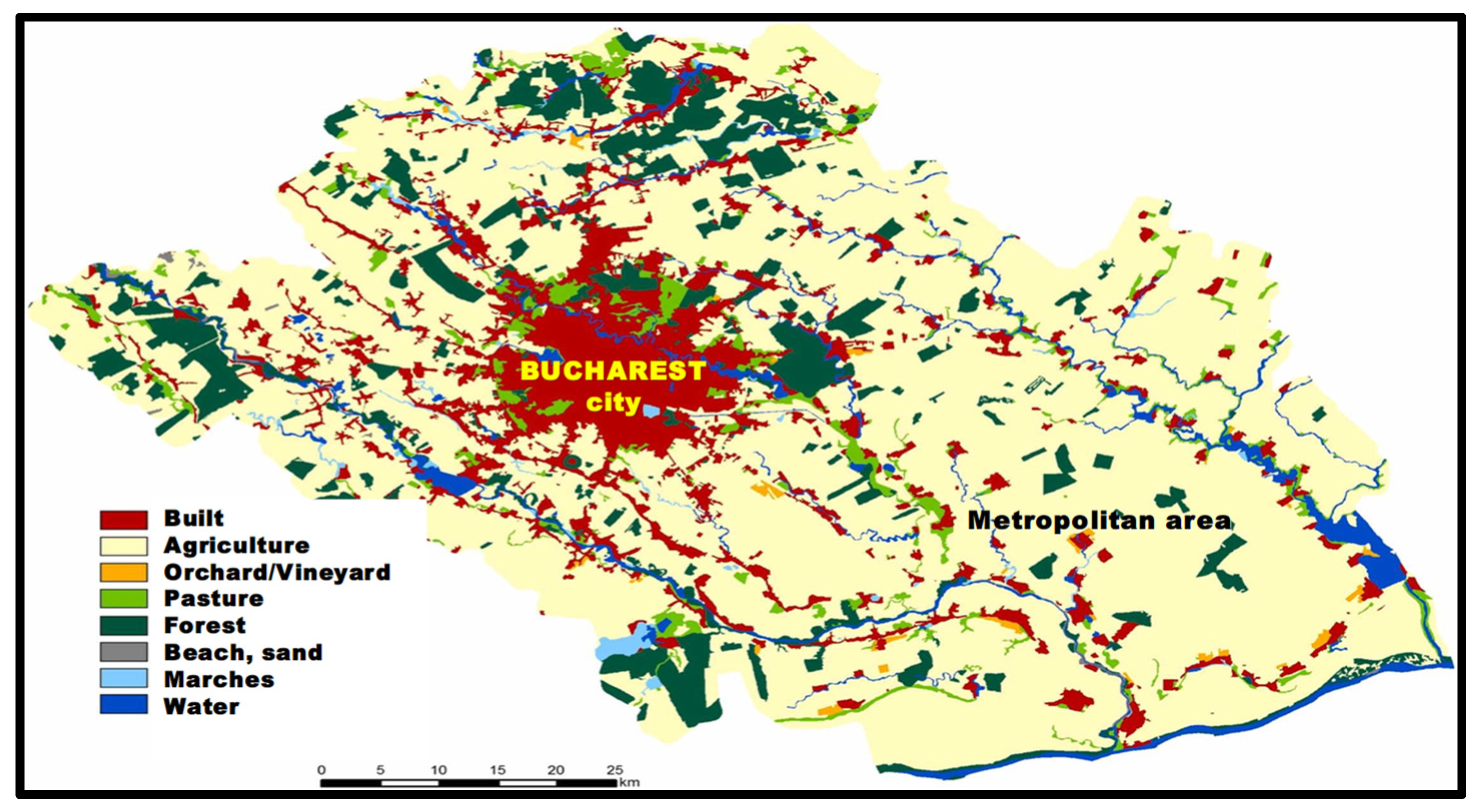
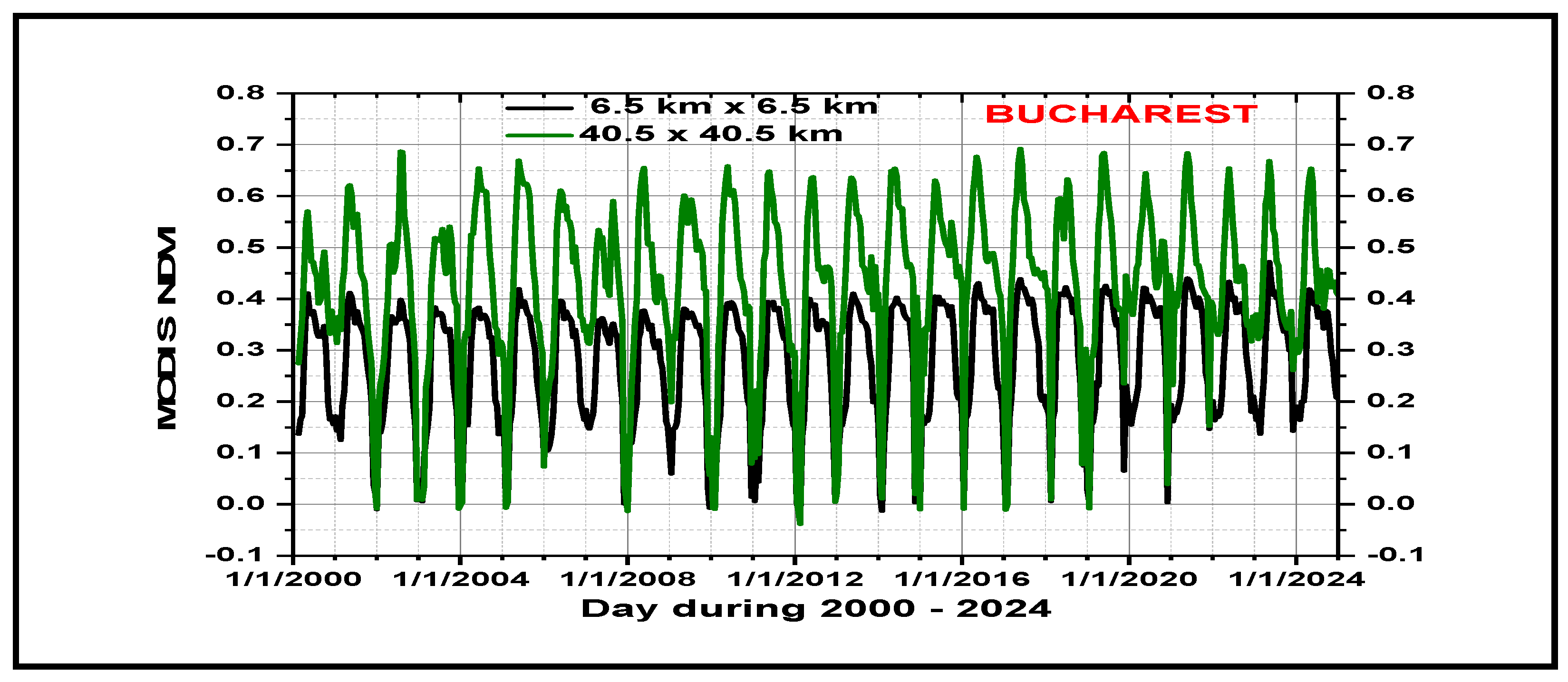
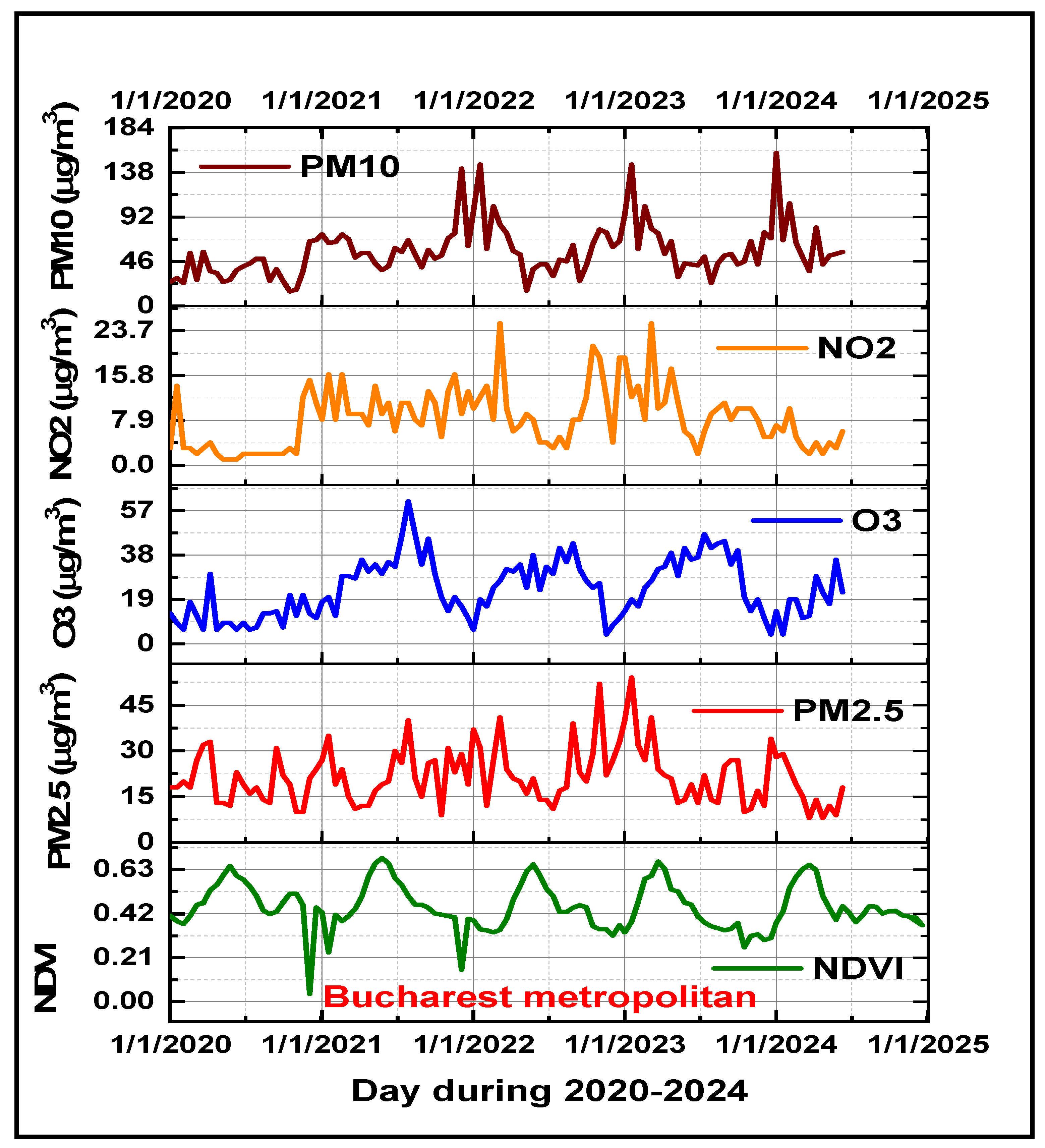
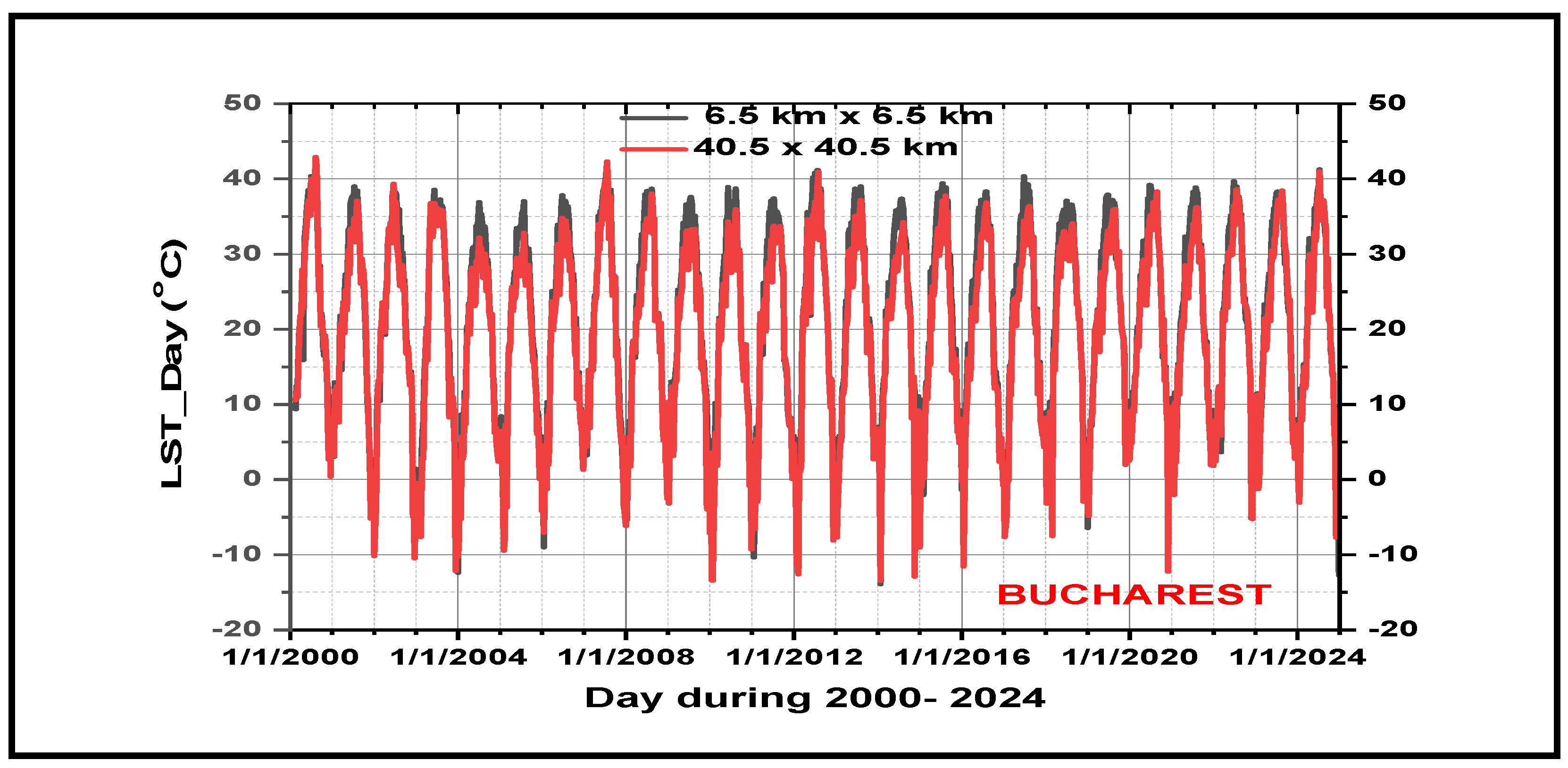

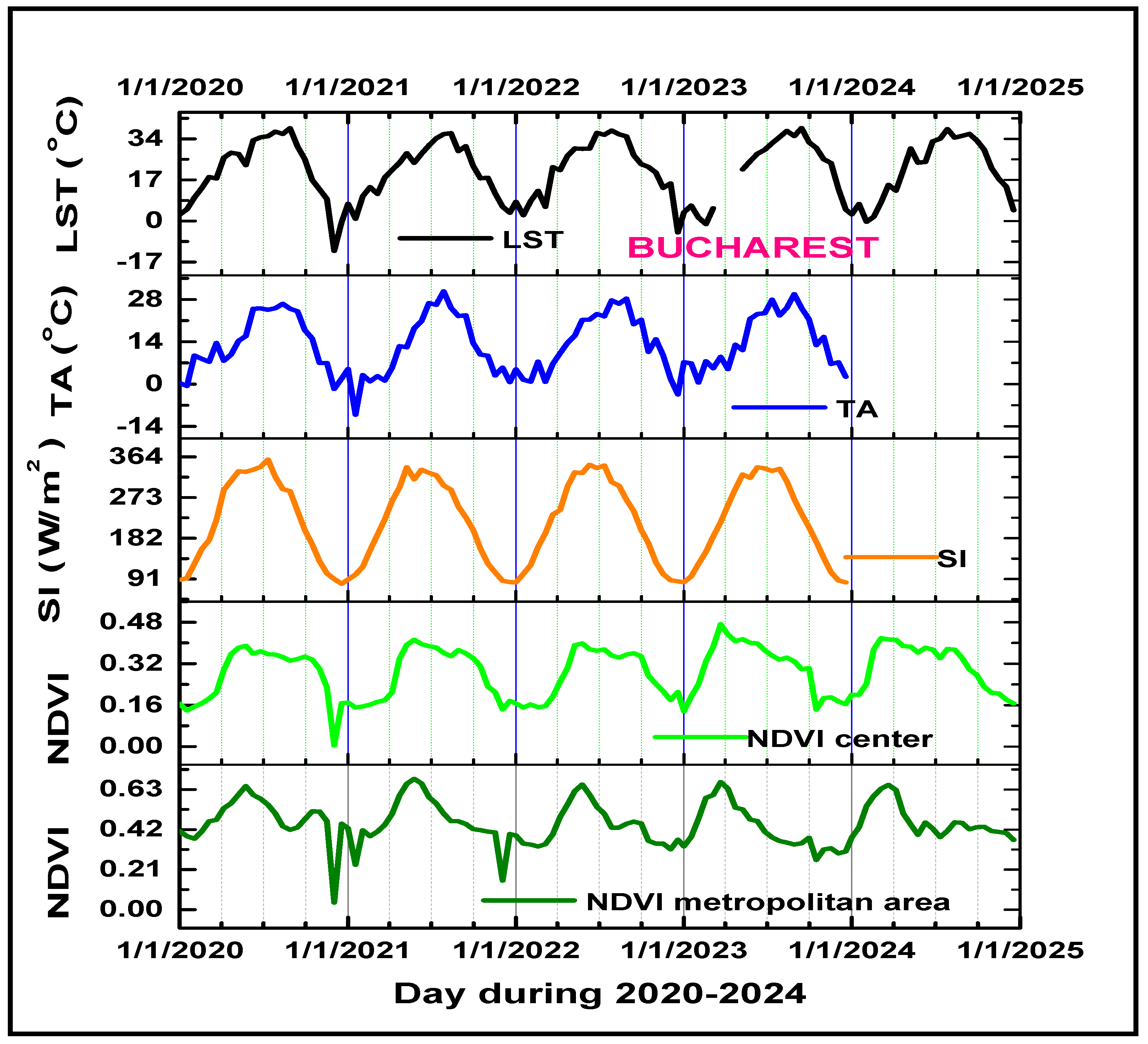

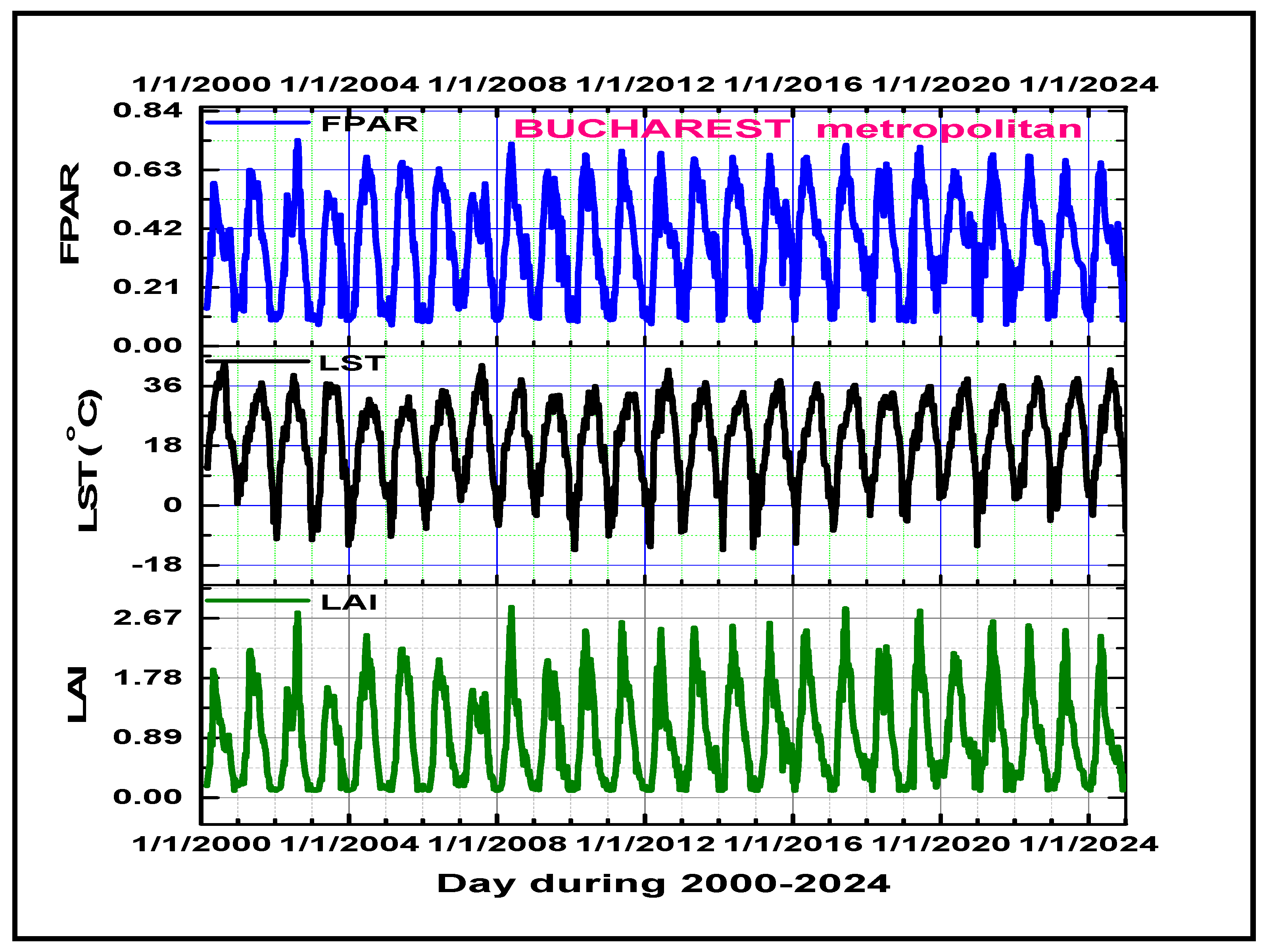
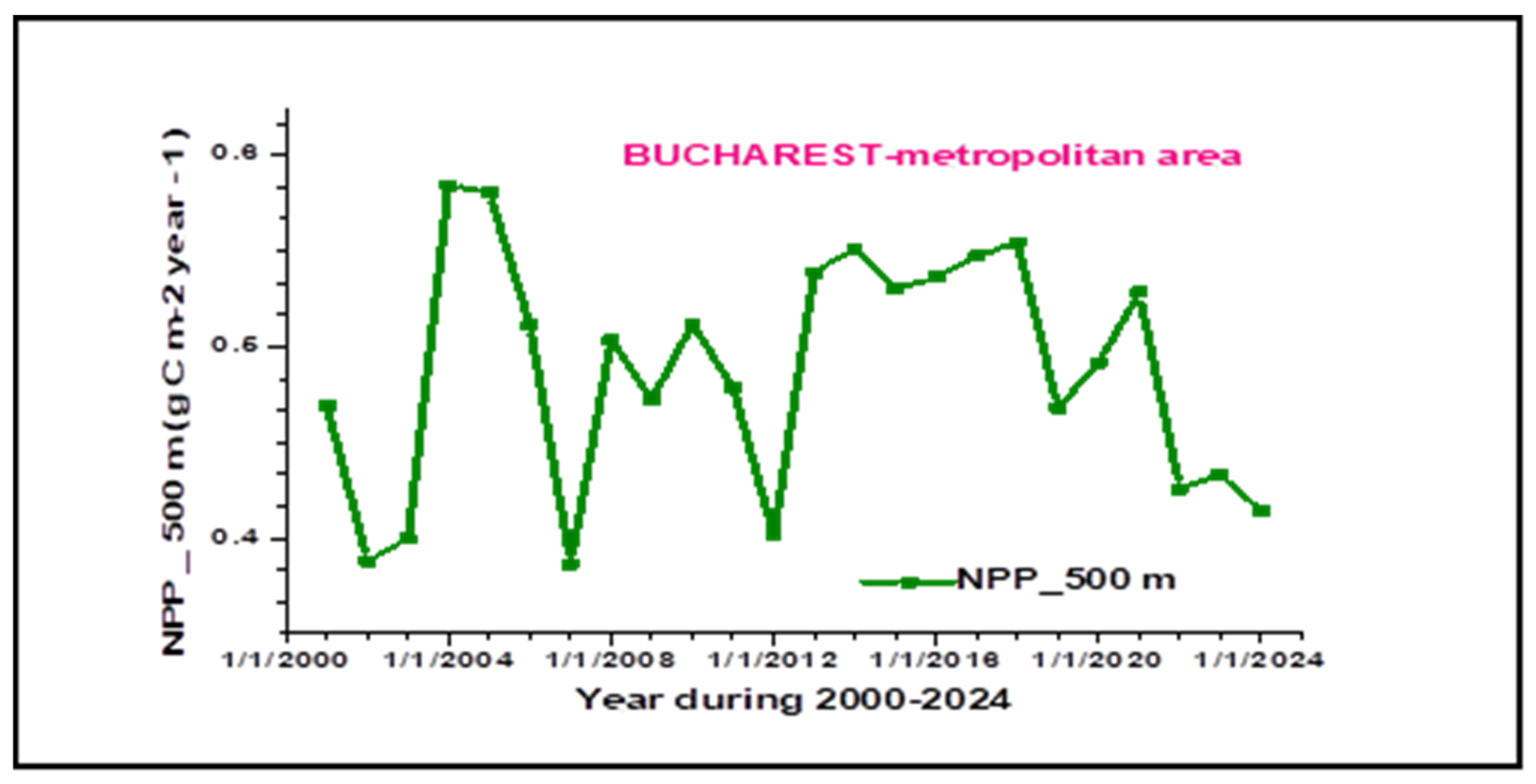
| Decrease of Agricultural Areas | Loss of Natural Areas | Loss of Wetlands/Water | Loss of Artificial Area | Other Changes |
|---|---|---|---|---|
| 71.9% | 1.3% | 1.3% | 12.3% | 13.5% |
| NDVI | PM2.5 | PM10 | O3 | NO2 | SO2 | CO |
|---|---|---|---|---|---|---|
| NDVI Bucharest Center area (6.5 km × 6.5 km) | r = −0.29 p < 0.01 | r = −0.58 p < 0.01 | r = 0.71 p < 0.01 | r = −0.47 p < 0.01 | r = −0.49 p < 0.01 | r = −0.61 p < 0.01 |
| NDVI Bucharest metropolitan area (40.5 km × 40.5 km) | r = −0.39 p < 0.01 | r = −0.56 p < 0.01 | r = 0.69 p < 0.01 | r = −0.52 p < 0.01 | r = −0.47 p < 0.01 | r = −0.49 p < 0.01 |
| NDVI | TA (°C) | RH (%) | PBL (m) | LST (°C) | LSA | SI (W/m2) |
|---|---|---|---|---|---|---|
| NDVI Bucharest Center area (6.5 km × 6.5 km) | r = 0.85 p < 0.01 | r = −0.68 p < 0.01 | r = 0.72 p < 0.01 | r = 0.88 p < 0.01 | r = −0.56 p < 0.01 | r = 0.82 p < 0.01 |
| NDVI Bucharest metropolitan area (40.5 km × 40.5 km) | r = 0.57 p < 0.01 | r = −0.45 p < 0.01 | r = 0.64 p < 0.01 | r = 0.65 p < 0.01 | r = −0.36 p < 0.01 | r = 0.65 p < 0.01 |
Disclaimer/Publisher’s Note: The statements, opinions and data contained in all publications are solely those of the individual author(s) and contributor(s) and not of MDPI and/or the editor(s). MDPI and/or the editor(s) disclaim responsibility for any injury to people or property resulting from any ideas, methods, instructions or products referred to in the content. |
© 2025 by the authors. Licensee MDPI, Basel, Switzerland. This article is an open access article distributed under the terms and conditions of the Creative Commons Attribution (CC BY) license (https://creativecommons.org/licenses/by/4.0/).
Share and Cite
Zoran, M.; Savastru, D.; Tautan, M.; Tenciu, D.; Stanciu, A. Spatiotemporal Analysis of Air Pollution and Climate Change Effects on Urban Green Spaces in Bucharest Metropolis. Atmosphere 2025, 16, 553. https://doi.org/10.3390/atmos16050553
Zoran M, Savastru D, Tautan M, Tenciu D, Stanciu A. Spatiotemporal Analysis of Air Pollution and Climate Change Effects on Urban Green Spaces in Bucharest Metropolis. Atmosphere. 2025; 16(5):553. https://doi.org/10.3390/atmos16050553
Chicago/Turabian StyleZoran, Maria, Dan Savastru, Marina Tautan, Daniel Tenciu, and Alexandru Stanciu. 2025. "Spatiotemporal Analysis of Air Pollution and Climate Change Effects on Urban Green Spaces in Bucharest Metropolis" Atmosphere 16, no. 5: 553. https://doi.org/10.3390/atmos16050553
APA StyleZoran, M., Savastru, D., Tautan, M., Tenciu, D., & Stanciu, A. (2025). Spatiotemporal Analysis of Air Pollution and Climate Change Effects on Urban Green Spaces in Bucharest Metropolis. Atmosphere, 16(5), 553. https://doi.org/10.3390/atmos16050553






